My Experiment with a Portable Wind Turbine for my RV
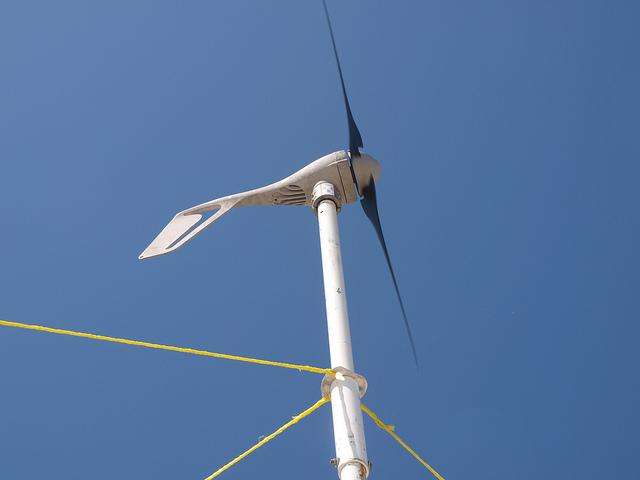
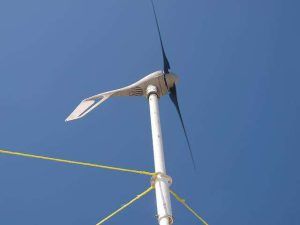 When I started out five years ago selecting modifications for my Roadtrek to support a full-timing, boondocking lifestyle, one thing I looked into was a portable wind turbine. Like solar panels, these allow you to generate electricity without burning fuel, so they're great for RVers, or so my reasoning went. The challenge was to design a mast to get the wind turbine high enough to generate power, yet lightweight and portable enough to pack up and carry with you.
When I started out five years ago selecting modifications for my Roadtrek to support a full-timing, boondocking lifestyle, one thing I looked into was a portable wind turbine. Like solar panels, these allow you to generate electricity without burning fuel, so they're great for RVers, or so my reasoning went. The challenge was to design a mast to get the wind turbine high enough to generate power, yet lightweight and portable enough to pack up and carry with you.
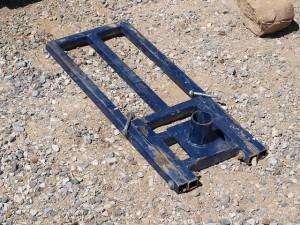
Scouring the internet, I found a mast base you could run over with your rear tire, with a hinged socket to put the mast in while the mast was lying on the ground, and then you pivot the whole thing vertically. However, these were no longer for sale, so I was forced to steal this idea, make some modifications, and get one welded up. Instead of a mast support three feet up or so attached to this base, I used a support that would attach to the Roadtrek, with suitable rubber bushings to prevent transfer of vibrations to the body.
Since I wasn't going to be able to carry a 20 foot mast in one piece, I made a mast with four foot sections of aluminum pipe, with a slightly larger size pipe sleeved over it to join the sections. A throughbolt at each junction, and I had something sturdy enough to stand up to strong winds, but still light and portable and easy on the GVWR – the total weight I could carry with my chassis.
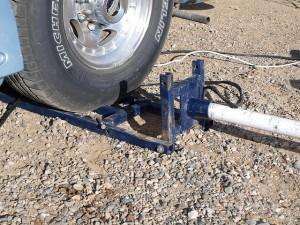
For a wind turbine, I bought an Air-X built by Sunforce. Nominal power is 400 watts – they now have two 600 watt models they sell. These models have integrated circuitry which regulates the output to prevent overcharging, as well as circuitry to prevent over-revving in high winds. Since the body is just a fancy permanent magnet alternator, putting the magnetic windings slightly out of phase will slow down the rotational speed if the wind is too strong, avoiding the annoying fluttering noise earlier designs made when they compensated for excessive wind speed. With this circuitry, the wind turbine can be wired straight to the battery bank, which I did by making a wiring harness which went down the interior of the mast to a quick-connect on the Roadtrek body near the mast base.
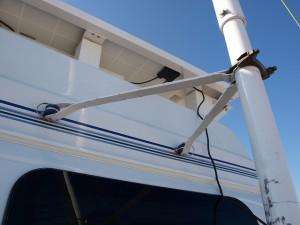
Off I went with my fancy new wind turbine, looking for good wind conditions. That's where the trouble started. Power increases as the square of the wind speed – it's the old F = MV^2 equation from Physics 101. The rated 400 watts would show up all right – in a steady 28 mph wind – not exactly ideal camping conditions. At half the optimal wind speed, you only get a quarter of the rated power – 100 watts. Other than a nice steady wind off the Gulf down at Padre Island National Seashore, I never found conditions where the wind turbine would keep up with the 200 watt demand of my normal usage pattern (TV, internet, and laptops, plus some lights).
Most of the time power production at inland locations was in fits and starts as the wind picked up and dropped off, or changed direction. My mast was only 20 feet high – permanent mountings are usually at least double that to get clean air flow without interference from the surface. I just couldn't design a tower that high which would be sturdy and still collapse into storable and transportable pieces, so I almost never got clean air flow.
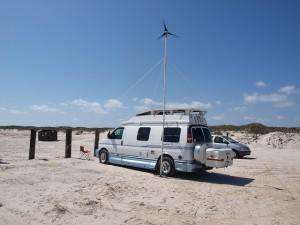
A final consideration was the carbon fiber blades, which were marvels of engineering. However, I had to take them off the hub every time I used it to get it down to a storable size, and it's an exacting process of torquing the fasteners. Carbon fiber is very strong but it needs careful handling to avoid damaging it. The blade tips are barely subsonic at maximum power output, and structural failure will send sharp pieces flying into nearby objects, like my solar panels for instance. Or maybe me. There's a reason you see wind turbines mounted out in a field far away from residences, and the mounting I designed wasn't able to utilize this common-sense precaution because it used the Roadtrek weight and structure to stabilize the mast.
Compared to my solar panels, the wind turbine was a lot of work. It only took thirty minutes or so to set up, but since the mast was attached to the Roadtrek body it would have to be lowered and disassembled every time I had to drive somewhere for water or groceries, so it never stayed up for more than a few days at a time. In contrast, the solar panels were always there and in position – all I had to do was park in the sun. No work necessary.
I carried the wind turbine around for a year and a half, using it on maybe a half dozen occasion, and then stored it when I decided that it just wasn't worth the weight and space it took up in my limited onboard storage capacity. Maybe someday I'll settle down in a mountain pass or on the ocean and can mount it where it will do some good, but my conclusion is that solar is the way to go for RVs, not wind power.

My thinking is you attach to the roof, with small blades and have it facing the front spinning as you’re driving to give you the power for heat or a/c. Then when parked face into the wind, and it will spin. You don’t need to attach to a tall pole. When you are on the ground walking and feel the wind, you know it’s there, so putting it on a tall pole, is rather a waste of time. It will work just as well attached to the roof, giving room for the smaller blades to rotate without chipping the roof paint so to speak.
We camp in snow country for our Winter work. We have solar but was thinking about adding Wind power for those long weeks of winter storms when there is no sun. Would it work for that? We would not be moving.
Hi RT Campskunk,
the article is from 2013. I would like to know, whether your longtime-experiences are still the same enthusiastic, as the article, which I found only 2 days ago.
Sorry for my english, It is not my mother language.
I sell yachts used in US and around the world. Wind gens are of little use in US as little dependable wind. Solar much more dependable. I cruised 5,000 miles on sailboat w/wind gen and only good in Caribbean or off shore.
Under City Data stories about Living Off the Grid in TN (eastern tn) they used both and eventually went just to solar I believe. Very interesting.
Updates….curious about info??
what would it cost to run a house with solar and wind turbine power.
Great idea1
Noisy!
the old ones with mechanical feathering (slowing down the propeller in high winds) were noisy, but this unit has electronic feathering. it is very quiet.
I wanted one, but thanks 4 your info. I will stick to solar for now!!!!
I could use one how many watts does it generates?
These are a lot smaller than the big turbines on the wind farms though……correct?
yes, the blades are maybe 15-16 inches long.
that would work more efficiently if it was in the shape of a sail. that would catch the wind better. you would not need a fast moving wind. just a slow steady wind. they don’t put propellers on sail boats to catch the wind and move the boat. that wouldn’t work very well.
Does it work
Ham Radio Antenna?
Hmm.
Might be a good investment.thinking on it.
No different than a boat, same system types! Had one too and powered things nicely and kept batteries charged without running engine. 🙂
Thank you for sharing. I had thought about wind power. Not now. I also thought of the conflict between camping in the wind. Time to pack up if it is blowing that hard.
yep, you can get all 400 watts in a steady 28 mph wind, but what are you going to do – stay inside all the time?
Lizbeth Kono
Had one on our sailboat along with a solar panel that kept our batteries charged. Love being independent!
I own one on my 5th wheel and my dad owns one on a custom stand for his big rv
Well darn Campskunk…I guess it was worth the effort because at least you don’t wonder if it would have worked! I know that would have driven you crazy!
I was wondering about stacking solar panels.
When you parked your RV you could roll the second panel out from under you permanent fixed panel, on a track similar to a garage door.
Double panel area, yet safe well traveling.
Campskunk, what is your opinion on the portable and foldable solar panel? One day I plan to buy E-Trek, and I thinking of adding portable solar panel whenever I’m boondocking. It can be kept stowed when I’m at campground, of course.
IF you can stow it securely while traveling, and IF you can secure it against wind when deployed, a portable solar panel is a good idea. if it were me, though, i’d just fasten it to the roof and not have to worry about it. it’s tempered glass, which is relatively sturdy, but it’s still glass, and it’s big and unwieldy, plus it’s heavy. if you have to lug it around with you month after month and year after year, sooner or later the law of averages is going to catch up with you.
You are correct! I’m almost forgot those thing. I was browing portable solar at amazon/walmart before coming to that idea. Might as well as look at the underutilized area of etrek rooftop and try to maximize it.
I was wondering what happened with your wind turbine. In Mike’s “Campskunk Style” video you were showing Mike how you mounted it to your Roadtrek. But until now, I don’t think I
ever saw any pictures with the wind turbine mounted. 🙂
Thanks for the article, CS. It’s good to hear about things that don’t necessarily work as we hope as well as the good stuff that does.